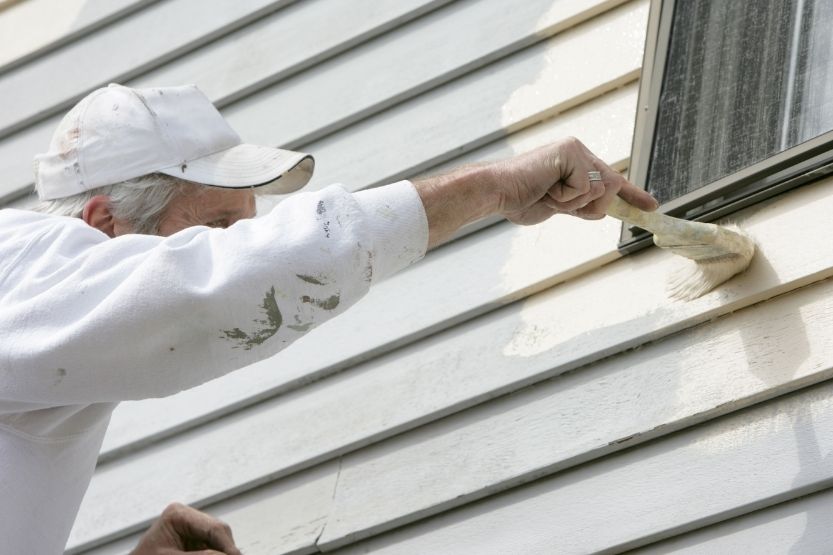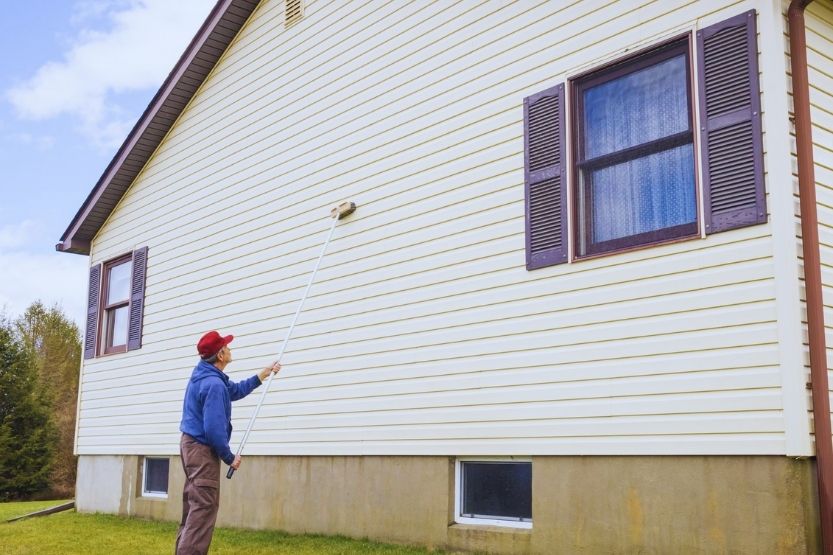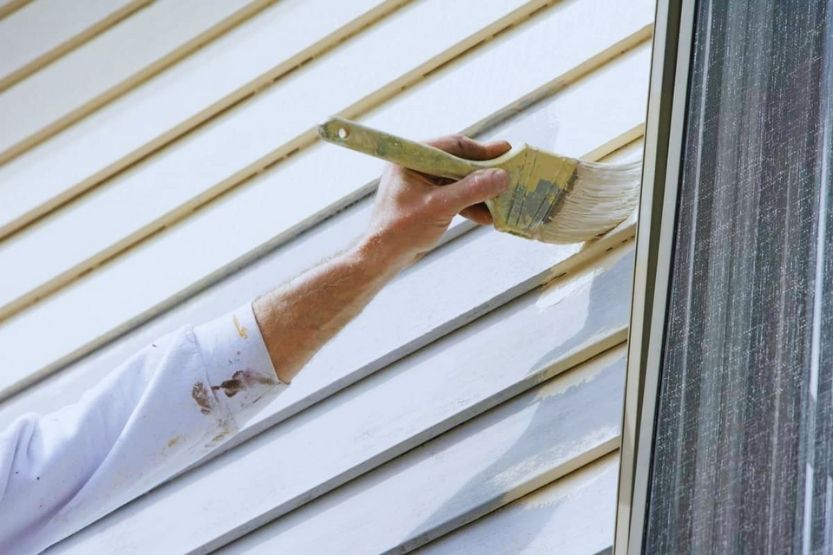After years of service, your home’s vinyl siding finally looks worn out and unattractive. To improve the appearance, you may want to paint it. Can you paint vinyl siding instead of replacing it?
You can paint your vinyl siding. It’s not only cheaper (compared to buying new ones), but it also gives you the freedom to choose the colors and color scheme that you think will give your vinyl siding an entirely fresh look.
Keep reading for everything you need to know about painting vinyl sidings—from important considerations to our step-by-step guide on how to paint them.
5 Factors to Consider Before Painting Your Vinyl Siding

So, now you know the quick answer to the question, “Can you paint vinyl siding on the house?” But before you spend your time and money on this project, keep the following things in mind to make sure the paint job doesn’t turn out badly:
1. Warranty Conditions
The standard warranty on vinyl sidings is fifty years. Most warranties guarantee that the vinyl sidings you plan to buy will protect your home against defects and damages.
However, most major manufacturers of vinyl sidings don’t honor their warranties if you refinished, varnished, or painted over their original finish. Before you hire a professional painter and buy supplies, make sure to check the specifics of the warranty first.
2. Cost of Painting
In general, painting vinyl sidings can cost between $2.01 and $3.92 per square foot. Aside from paint and labor, you also need to take into account the costs of equipment. For painting exterior vinyl sidings, you’ll need:
- An extension ladder,
- A pressure washer,
- Scaffolding,
- Sprayers,
- Surface-prep tools, and so on.
You can do it yourself, but make sure you’re prepared to dedicate many hours to the project. Paining the vinyl siding of any home is a time-consuming task. The upside is it’s significantly more affordable than replacing old vinyl sidings.
3. Right Color and Application Process
Not all types of paints will stick to the surface of the vinyl. Therefore, it’s important to know about this to avoid wasting your money and negatively impact the resale value of your home.
The ideal type of paint for vinyl sidings is water-based paints containing acrylic and urethane resins. These two substances are commonly used in the surface coatings industry because of their ability to tightly adhere to the surface of vinyl materials, especially when they contract and expand.
4. Check for Damages
Repainting your vinyl sidings is a good opportunity for you to check for any signs of damage, like rotting and insect pests infestation. This, of course, could mean additional costs.
Ask yourself: Are you prepared to pay for repairs if your professional painter or contractor finds any damage? Depending on the type and extent of damage, repairs could cost you $50 to $500 (or more).
5. Energy Efficiency
Vinyl siding can affect the energy efficiency of your home. This doesn’t only refer to the material itself but also the paint color you use. In general, lighter-colored exterior paints are more energy-efficient if you live in an area that gets a lot of heat and sun.
If you live in a colder area, darker-colored exterior paints are a better option because they can absorb up to 90% of the sun’s energy.
Note: If you want to increase your energy savings significantly, consider replacing your old insulation or adding an extra layer of insulation under your new or old vinyl siding.
How to Paint Vinyl Siding

I highly recommend getting a professional painter to do this for you. But if you’ve painted anything else before and you’re confident with your skills, the information below will take you through the process and technique for painting vinyl sidings:
1. Prepare the Surface Area
This is probably the most important step of painting your vinyl siding. Paint might stick to a flaky and dirty siding in the short term, but it’s bound to fail over the years.
There are two ways to do this:
Use a Pressure Washer
A pressure washer allows you to cover more surface area in less time. Plus, you can conserve your energy because it does the heavy work for you.
It has downsides, so make sure to consider them seriously. For instance, if you don’t use it correctly, it could damage your siding and introduce water underneath it.
Should you buy or rent one?
A brand new electric pressure washer could cost you between $100 and $400, while a gas pressure washer typically costs $300 and $600. Meanwhile, renting a pressure washer could cost you $40 to $100 per day.
It really depends on individual needs. Buying a pressure washer could be a good investment for you if you plan to use it for other purposes, like cleaning mildew from your patio furniture or concrete driveway.
Important:
- Depending on the humidity, temperature, and weather in your area, it takes at least one day for a siding to dry after a power wash.
- Power washing isn’t a good option if the old paint of your vinyl siding contains lead. (Homes that were built before 1978 were usually painted with lead-containing paint.) If you want to be sure, you can contact your local health department to ask for assistance or have your chosen paint tested.
Manual Cleaning
Hand cleaning is considered the best method for preparing the surface of vinyl sidings. It doesn’t only remove dirt better than pressure washing, but it also gives you the chance to inspect the condition of your home’s siding closely.
It also doesn’t require expensive cleaning tools. Some of the basic tools you’ll need include:
- Brushes (including one with a long handle),
- A bucket,
- Broom (for hard-to-reach parts),
- Ladder,
- Hose, and
- Microfiber cloths.
But, let’s face it—scrubbing and washing a house exterior by hand can be exhausting and time-consuming. It can also be dangerous since it involves climbing ladders to reach those higher parts.
2. Find the Right Temperature and Weather Before Painting
Like any paint job, waiting for the most suitable weather is the key to success. Only start working on your home’s exterior vinyl siding if the weather will be good for the next couple of days.
To stick to the vinyl siding properly, most vinyl paints will require temperatures above 40° F (4.44° Celsius) but less than 90° F (32.22° Celsius). Also, they need more than two days of curing time in warm weather, low relative humidity, and mostly cloudy sky.
If you apply vinyl paint in cold weather, dew could form on the siding’s surface. The cold weather could also prevent water in the paint to completely evaporate and affect its ability to resist cracking.
Painting in hot weather conditions is also not a good idea. If the surface of your vinyl siding gets too hot, the paint wouldn’t adhere and could blister, crack, or peel.
3. Choose and Apply Primer
This step is optional. You don’t usually need to apply a primer on a vinyl siding unless it has areas that have become faded and pitted or porous. Priming is also necessary if you’re switching paint types.
If priming is necessary, your main concern is choosing the right type of primer for vinyl. Most of the time, an adhesive or a bonding primer is highly preferable. It’s usually more expensive, but that’s because it’s specifically formulated to tightly bond to this material. And depending on the brand, it can hold lots of different coatings, including solvent-based coatings.
In most cases, you only need to apply a single coat of primer. You need to know when you’re using too little or too much primer. If you skimp on primer, your vinyl siding will absorb too much paint, causing it to look dull and blotchy. If you apply a lot of it, it could cause cracking, chipping, or lines. Drying time also takes longer than usual.
Tip: You’ll know if you’re using too much primer if it’s dripping off your brush or roller as you apply it.
4. Choose the Appropriate Paint
When choosing the proper paint, you have two important things to consider:
- The ingredients the manufacturer used
- The color (dark versus light)
Let’s talk about the ingredients first. Normally, you don’t need to think about this too much because some manufacturers sell paints that contain specific ingredients that are safe for vinyl materials.
Vinyl-safe Paint
What’s a “vinyl-safe” paint?
It means that an exterior paint contains acrylic and urethane resins. As I’ve mentioned earlier, these two compounds allow the paint to contract and expand as your vinyl siding cools or heats up. If it were another type of paint, it would easily crack and flake over time.
If your choice is between acrylic and latex exterior paints, the former typically works much better with vinyl siding. Acrylic exterior paint is lightweight, flexible when it dries, and tightly sticks to vinyl.
Color of Paint
Another consideration is the color of the paint you’re going to use. Most experts suggest avoiding dark-colored paints because they absorb a lot of heat from the sun. This would most likely lead to warping and bubble formation over time.
Tip: Look for a “vinyl-safe” siding paint with a Light Reflective Value (LRV) of more than 55%. The LRV scale tells you the amount of light a certain color reflects.
It’s measured on a scale that ranges from zero percent to a hundred percent. Zero percent means absolute black (absorbing all light and heat), and a hundred percent means pure white (or a bright yellow).
5. Apply Your Preferred Paint
To apply your vinyl paint, you can use a brush, roller, a sprayer—or a combination of any of these three. But spray painting is still the best application method. It provides a faster and cleaner finish, which closely resembles the original factory finish.
So, what’s the best type of paint sprayer for siding?
Get an airless sprayer. This type of paint sprayer can efficiently cover large surface areas fast. In fact, it can save you as much as ten times the amount of time compared to when you use a paint roller.
You can rent airless sprayers at most home improvement stores. The rental fee could range anywhere between $40 and $120 a day, depending on the unit you go with.
Make sure to use the appropriate tip size for the paint you’ll be spraying on your vinyl siding. The rule of thumb is lighter coatings need a small spray tip, while heavier coatings need larger spray tips. Fortunately, most manufacturers indicate the proper spray tip size on the paint can.
Again, can you paint vinyl siding? Painting your vinyl siding is a cheaper option than buying a new one. With this option, you can also choose the color to get your vinyl siding a fresher look.
Other Tips You Should Keep in Mind When Painting Vinyl Siding

Other things to keep in mind when applying your exterior paint for vinyl siding:
1. Apply Even, Thin Coats
Apply even, thin coats. Thicker coats will dry longer and might not stick well to your siding.
2. Spray Two Coats
Spraying two coats is often enough to get the best coverage and durability.
3. Wait for the Paint to Dry
Wait for the paint to dry—if not fully, then most. After the first coat of paint is dry, apply the second coat, then wait for at least 24 hours to fully dry. After that, check the appearance of the second coat to know whether you need to apply another coat of paint.
4. Spray Paint from Left to Right, Top to the Bottom
Start spraying paint on your vinyl siding from left to right, top to the bottom.
As much as possible, don’t stop or start in the middle of your siding.
5. Start Painting from the Shaded Side of Your House
Always paint starting from the shaded side of your house. Remember: Direct sunlight causes paint to dry too quickly, preventing it from properly adhering to your vinyl siding.
Conclusion – Can You Paint Vinyl Siding?
So, yes, you can paint vinyl siding. Not only is it possible, but it’s much cheaper than putting on new siding on your home. If you’re a creative person, it’s a great opportunity for you to choose harmonious and stylish color combos to get a brand-new look.
But don’t forget that you can’t undo this process once you start it. So, carefully weigh the upsides and downsides of painting your vinyl siding before opening that paint can.


![Read more about the article What Is a Comfortable Dew Point? [Comfortable Dew Point Range]](https://howchimp.com/wp-content/uploads/2021/04/comfortable-dew-point-300x200.jpg)
![Read more about the article Baby Brown Recluse Spider: How to Identify, Is It Dangerous? [With Pictures]](https://howchimp.com/wp-content/uploads/2021/05/baby-brown-recluse-300x200.jpg)